

(By Kentaro Iwamoto)About two weeks after China signed the Regional Comprehensive Economic Partnership trade megadeal with 14 other Asia-Pacific economies, Premier Li Keqiang stressed the need to walk the talk.
“As a member of the RCEP, our country should actively promote the implementation of the agreement with our own actions, safeguard free trade and expand new space for win-win cooperation,” Li said at a State Council executive meeting in Beijing on Dec. 1, 2020.

The RCEP grouping of China, Japan, South Korea, Australia, New Zealand and the 10 members of the Association of Southeast Asian Nations constitutes around 30% of global GDP and population. One estimate, published by the U.S.-based Peterson Institute for International Economics before the Nov. 15 signing, projected the deal could add US$ 500 billion to world exports in 2030.
The big three East Asian countries — connected by a free trade agreement for the first time — stand to gain the most, according to the study. China’s exports are projected to rise by US$ 248 billion thanks to RCEP, with Japan seeing an extra US$ 128 billion and South Korea US$ 63 billion. Trade among them should account for a significant portion of the increase.
Another study by the Japan Institute of International Affairs indicated that South Korea may see the biggest economic contribution, with RCEP adding 6.5% to real GDP while Japan gains 5% and China 4.6%.
Sachs agreed that “China, Japan, and South Korea together form a technological powerhouse, and by joining together in RCEP, that technological dynamism of the three countries can be greatly enhanced.” But he also emphasized that ASEAN countries and the whole region should benefit from “peaceful cooperation, more foreign investment, and faster upgrading of digital and green technologies.”
All this hinges on ratification. But an Economist Intelligence Unit report predicted the required six ASEAN countries and three non-ASEAN states will approve the deal by the third quarter of 2021. For now, signatories are weighing how to get the most out of the accord.
In December, the South Korean government hosted a meeting with steel, automobile, machinery and textile industry associations — four sectors expected to reap the sweetest rewards. RCEP countries accounted for 53.2% of South Korea’s steel exports in 2020, up from 46.8% in 2019. The steelmaking association expects a 4.3 million ton increase in ASEAN demand for the material in 2021, to 77.3 million tons.
South Korean automakers hope RCEP will help them eat into Japanese rivals’ 74% share of a Southeast Asian market with 650 million people and 3.5 million annual car sales.
Japanese carmakers, of course, want more ASEAN sales themselves. And Japan’s industrial equipment makers will enjoy tariff-free access to China on 86% of products, up from 8%, while South Korea will remove tariffs on 92%, up from 19%.

As for ASEAN states already taking advantage of existing FTAs, reduced non-tariff barriers will lead to lower import costs and greater competitiveness, according to Kensuke Yanagida at the Japan Institute of International Affairs. He said Malaysia, the Philippines, Singapore and Thailand can expect more electronics exports, for example.
Beyond tariffs, “RCEP harmonizes rules-of-origin provisions and establishes a single set of regional content rules, effectively creating a single market for intermediate goods that will promote the creation of supply chains across the region,” sid the EIU report. The think tank added that an integrated customs regime could drive foreign investment into smaller ASEAN markets where regulatory uncertainty is an impediment, such as Myanmar, Laos and Cambodia.
This acceleration of Asian trade and investment would follow a sharp global deceleration. Due to the COVID-19 pandemic, the World Trade Organization forecast in October that global merchandise trade volume would shrink 9.2% in 2020. The International Monetary Fund projected a 4.4% decline in world GDP for the year.
Other recent developments suggest China — one of the few economies set to post growth for 2020 — is determined to grab the reins of the global economy and gallop out of the COVID crisis.
Just before New Year’s, Beijing sealed an investment pact with the European Union. Days after the RCEP signing, Chinese President Xi Jinping also expressed interest in joining another trade megadeal, the 11-member Comprehensive and Progressive Trans-Pacific Partnership.
But some see complications ahead.
Raj Bhala, a distinguished professor at the University of Kansas specializing in trade law, noted that RCEP is less ambitious than the CPTPP and other major deals when it comes to “breadth of coverage” of goods and services, foreign direct investment and intellectual property.
Alex Capri, research fellow at the Asia-based Hinrich Foundation, made a similar point. Capri said RCEP is a welcome vision of multilateralism but warned the members “have disparate capacity to enforce ‘deep’ trade standards.”
“In general, the agreement allows individual countries to opt out and cherry pick key provisions. At best, it’s a tiered agreement,” said Capri, also a visiting senior fellow at Singapore’s NUS Business School. “Indonesia, for example, has asked for a two-year delay to implement trade facilitation provisions. Even as RCEP champions E-commerce, investment and dispute settlement, individual countries in the region are doubling down on data localization laws.” “Will the agreement’s provisions ultimately be broadly and uniformly enacted and enforced? I doubt it.”

Limited ambition and uncertain implementation are not the only factors that could stop RCEP from tipping the global balance. Both Bhala and Capri pointed to Joe Biden’s victory over Trump in the U.S. presidential election, and his desire to reassert American leadership.
Biden has not said whether he would consider joining RCEP or reversing Trump’s decision to withdraw from what became the CPTPP. But in a Dec. 28 speech, the president vowed to “regain the trust and confidence of the world.”
Bhala predicted that Biden’s first couple of years might not bring a major free trade move, “but thereafter you’ll probably see some stronger efforts.”
Source: Nikkei Asia
Original Title: RCEP: China to Gain as Trade Pact Ripples Across Post-COVID-19 World
桂ICP备14000177号 Copyright@2006-2013 Guangxi China-ASEAN Panorama Magazine Agency Co., Ltd. All Rights Reserved